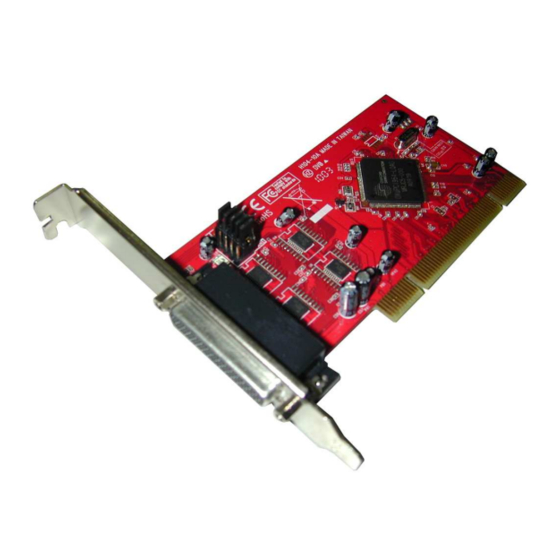
Summary of Contents for Lindy 51274
- Page 1 Low Profile 32-Bit PCI 4 Port Serial Card (16C950 128FIFO) User Manual English LINDY No. 51274 www.lindy.com © LINDY ELECTRONICS LIMITED & LINDY-ELEKTRONIK GMBH - FIRST EDITION (February 2010)
- Page 2 Introduction This PCI Host Adapter is a PCI controller board which can upgrade your desktop computer to provide multiple RS232 (UART) ports. The board supports a 32-bit 33 MHz PCI bus revision 3.0, RS232 transfer rate of 920 Kbps. The low profile form factor can support both low profile and standard expansion slots. It comes with drivers for Windows 98, ME, 2000, NT4.0, XP, VISTA &7.
-
Page 3: Package Contents
Package Contents RS232 PCI Adapter Card This manual Low Profile & Standard PCI Brackets Driver CD Breakout cable (for 4 Port and 8 Port cards only) 5V Jumper Settings for each RS232 Port DC5V on Pin9 of DB9 Connector = Short Normal RI function on Pin9 of DB9 Connector = Short... - Page 4 Verifying correct installation (Windows 2000 and XP) Follow the instructions in this section to verify that the controller was installed correctly. 1. Click Start and then select Control Panel. Double click System then select the Hardware tab. Click on the Device Manager button. 2.
- Page 5 Windows 98 / ME installation 1. Power off the system. Remove the case covers and carefully insert the PCI Card into an available PCI slot. Replace the covers and power up the system. 2. The Hardware wizard will display the Found New Hardware Wizard. Select Specify the location of the driver (Advanced) and insert the driver CD into your CD-ROM/DVD drive.
- Page 6 Verifying installation (Windows 98 and ME) Follow the instructions in this section to verify that the controller was installed correctly. 1. Right click on the My Computer icon, select Properties, left click on the Device Manager tab. 2. Double click Multifunction adapters, If there is no yellow “!” or “?” in front of OX16PCI954 PCI UARTs OX16PCI95x PCI bridge the driver has been installed correctly.
- Page 7 Windows NT4.0 installation Power up the system, and insert the driver CD into your CD-ROM/DVD drive. Browse the driver CD, and specify the driver location, example: E:\PCI IO Host\OXmPCI \Windows exe \NT4_Serial. Double click on the Install_Serial icon. The wizard will display Windows NT4 Device Installer. Click Next. The wizard will display OxSer.INF.
- Page 8 LINUX Installation Procedures For Linux Kernel 2.4.18 and above (including RedHat V8.0), IO-104 serial ports can be automatically detected and installed. The following descriptions show the necessary steps to double check that the IO-104 serial ports have been configured correctly by the Linux platform: 1.
- Page 9 3. Next we will check that the available serial ports reside in the system: [root@lnx test]# more /proc/tty/driver/serial serinfo:1.0 driver revision: 0: uart:16550A port:000003F8 irq:4 tx:0 rx:0 1: uart:16550A port:000002F8 irq:3 tx:0 rx:0 2: uart:16450 port:0000CC00 irq:9 tx:0 rx:0 3: uart:16450 port:0000CC08 irq:9 tx:0 rx:0 4: uart:16C950/954 port:0000C400 irq:9 tx:0 rx:0 5: uart:16C950/954 port:0000C408 irq:9 tx:0 rx:0 6: uart:16C950/954 port:0000C410 irq:9 tx:0 rx:0...
- Page 10 MS-DOS installation This is a DOS command line program that sets the PCI IO card's UART/parallel address to available COM/LPT ports. To start the setup automatically, add SETIO.EXE to autoexec.bat file and copy SETIO.EXE to c:\. Simply delete the SETIO.EXE line in the autoexec.bat file if you later decide not to run it automatically.
- Page 11 This device complies with Part 15 of the FCC Rules. Operation is subject to the following two conditions: (1) this device may not cause harmful interference, and (2) this device must accept any interference received, including interference that may cause undesired operations.















Need help?
Do you have a question about the 51274 and is the answer not in the manual?
Questions and answers